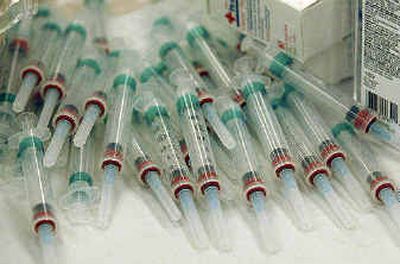Shortage is shot in arm for middlemen

Jack Bond’s hospital pharmacy needed 2,800 flu shots, but his supplier couldn’t provide them. Plenty of other distributors were ready to meet his needs, though _ for a price: as much as $600 for a vial of 10 flu shots that normally costs around $80.
With no other choices, officials at Wesley Medical Center in Wichita, Kan., thought about paying that price “as a last resort,” said Bond, the hospital’s pharmacy director.
Fortunately, other health providers in the area came to the rescue, sharing their supplies.
Around the country, health officials say some suppliers are trying to cash in on the flu shot shortage.
In Colorado, hospitals have been offered vaccine for about $100 a shot. In south Florida, one hospital was told the price would be $140 a shot, according to vaccine maker Aventis Pasteur, currently the only company providing flu shots this year.
And those are prices for the hospitals. Typically, a consumer can pay as little as $20 for a flu shot, depending on the location.
Hospitals and federal health officials were caught off-guard at the start of the flu season when the nation’s other major vaccine producer, Chiron Corp., announced it would be unable to provide the estimated 48 million shots expected this year. That’s nearly half the supply federal health officials had counted on.
The British government banned Chiron’s factory in Liverpool from shipping its vaccine because of contamination problems.
Because it takes months to develop vaccine, Aventis can’t make more vaccine in time for the flu season. Aventis has only about 55.4 million doses available for this season, simply not enough to go around. The government is negotiating with other vaccine makers in hopes of shaking loose a bit more.
When a flu shot leaves the factory, Aventis charges $8.50 for it, and the company says it has not raised the price since Chiron’s announcement. But prices easily can rise under the existing distribution system, which allows vaccine to travel from manufacturer to middleman before it reaches a hospital or doctor’s office.
“There are companies out there that buy up and speculate on drugs that they think are at short supply and turn around and resell them at 10 to 100 times the mark-up,” said Bryant Herring, assistant pharmacy director for Wellmont Health System in Kingsport, Tenn., which has declined flu shot offers ranging from $65 to $100 a dose.
“It drives up health care costs and also limits the availability for patients who may not be able to afford it or need it most,” Herring added.
Some states are taking action. In Kansas, Attorney General Phill Kline is suing Fort Lauderdale, Fla.-based Meds-Stat for allegedly trying to seek “unconscionable profits” by offering another Wichita pharmacy flu shots for about $90 each.
Dr. Julie Gerberding, director of the Centers for Disease Control and Prevention, said her agency is working with states to help prosecute price-gougers.
“Shame on the people who are price-gouging,” she said. “There’s no room for this kind of behavior in an environment where we need to pull together as a country to protect our vulnerable populations.”
There are many such vulnerable people – 98 million, the CDC says _ who should be immunized against the flu virus.
Those people include babies and toddlers ages 6-23 months; anyone 65 or older; anyone with chronic medical conditions such as heart or lung disease; pregnant women; residents of long-term care facilities; children on chronic aspirin therapy; health workers who care for high-risk patients; and caregivers and household contacts of babies under age 6 months.
As one remedy to problems caused by the shortage, the CDC and Aventis Pasteur announced Tuesday a plan to redistribute the company’s remaining shots directly to pediatricians, nursing homes and other places that care for high-risk patients.